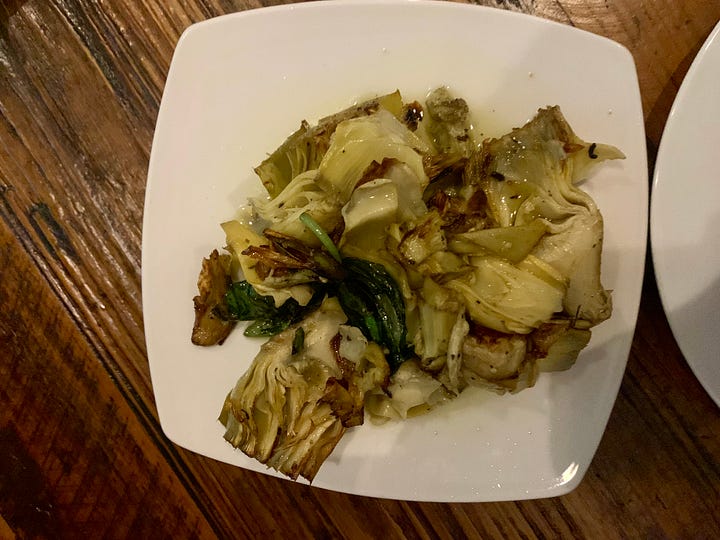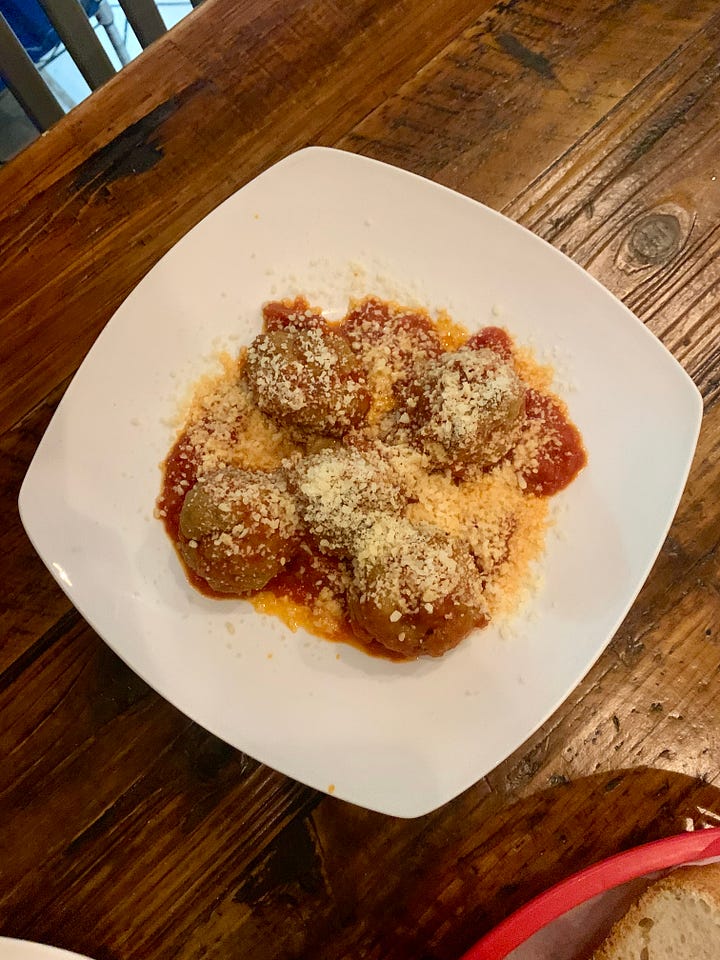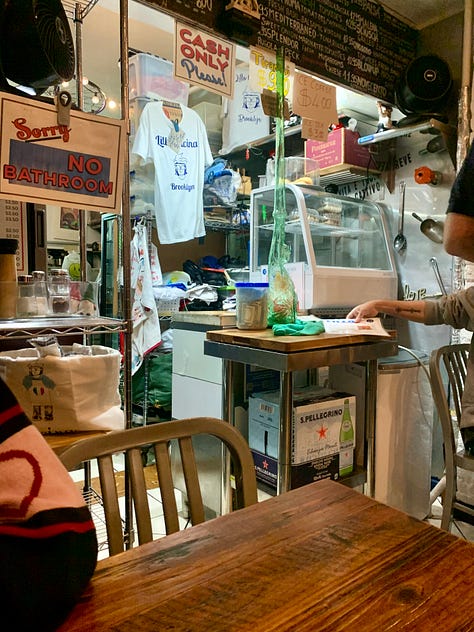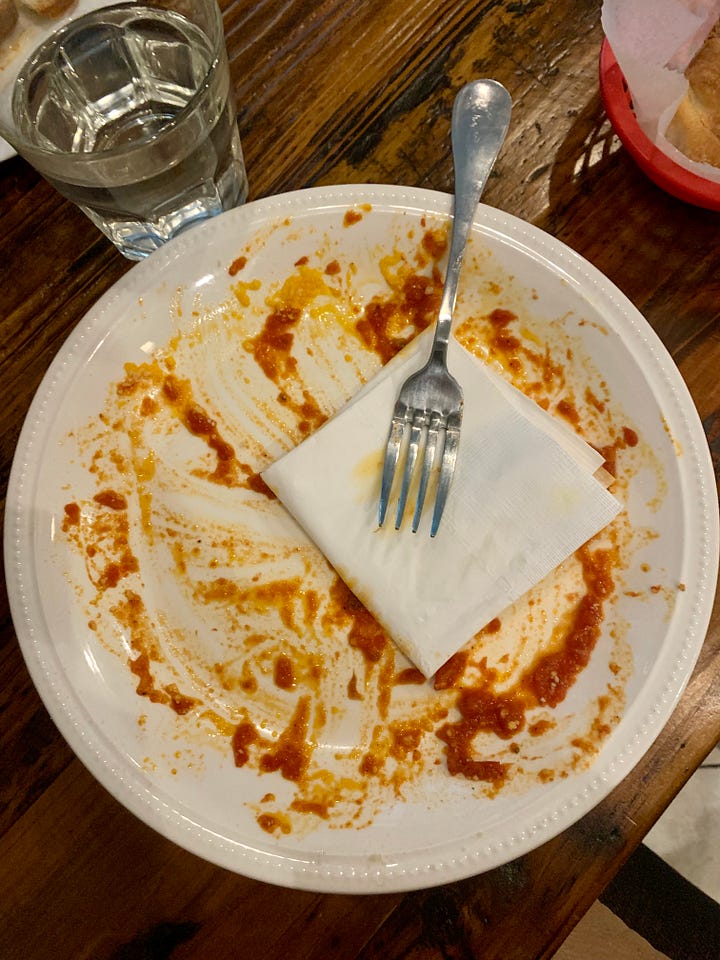I have been thinking about this country lately. Let me put it this way: A Canadian friend once told me that Canada (for all its problems) talks about society as a “salad bowl,” and I was glad to hear a food metaphor rather than an industrial one. Actually, as a child, I had always assumed “melting pot” was about fondue, but then a high school history teacher showed us pictures of the “graduation” ceremony for immigrant employees at the Ford Motor Company’s English school: They would wear their traditional dress as they walked into a larger-than-life cauldron, then collect their diplomas and emerge wearing suits and ties. And I get that a lot of people need cars for the time being, but mostly it still feels like the only good use of a melting pot is fondue.
Sometimes, a restaurant can be a reminder that a better world is possible, that there is maybe some version of something where nobody is melted down, where we are all meatballs rolling around and soaking up each other’s sauce.


At Lillo Cucina Italiana, the world is chalkboards and laminated menus, eggplant parm and sauteed cabbage. Lillo is fork on ceramic and scooching chair noises. Lillo is neighbors, Lillo is Atlantic Avenue hum. But Lillo is not a comfortable restaurant; it is tiny, there is no bathroom. There is no Resy and there is no line or list when you inevitably have to wait for a table. Lillo doesn’t serve alcohol, but it’s not BYOB, either, and it’s cash-only, but there’s certainly no ATM. The last seating is at 8pm (7 on Sundays). The owner (nickname: Lillo) will speak to you in Italian and you will have to figure it out. The specials are not printed out daily but rather scrawled in jerky cursive on pages of lined paper smacked up onto the wall with masking tape: Pollo Parmigiana NO PASTA $20.00. Pasta alla Checca COLD Farfalle - cherry tomatoes, fresh mozzarella, olive, fresh basil $16.00. Big Caprese ITALY Fresh Bufala Imported Mozzarella - 250 g $20.00.
If you engage much with food media, you’re probably aware of this idea that’s out there of cooking as some sort of universal welcome or hand outstretched. As though when conflict overwhelms, it’s simple enough to say: Well, in the end, people are the same everywhere, everyone just loves feeding people. Other than the obvious oversimplification—based on the available evidence, it would seem to me that many people do want everyone to have enough food, but others would at best kind of rather not think about it—I find the idea flattening in other ways, too. What about cooking as a churning force within? The imaginative, expressive, challenging cooking I love? And what if the diner sometimes takes on the onus of welcoming, or sometimes needs to show love by reaching out their hand?



Being inside Lillo is like being inside a brain—a cluttered, forgetful brain, an overactive one that paces back and forth between its ideas and tasks. In the afternoons, it’s a coffee and cornetto place with sandwiches like the Sciuscia (“shoeshine,” a De Sica movie) with sundried tomatoes, grilled zucchini, and mozzarella di bufala, or the Novecento (“twentieth century,” a Bertolucci movie) with mortadella, artichoke, and grana padano, or the Amarcord (“I remember” in Fellini’s home dialect, or, yes, a Fellini movie) which is just prosciutto on focaccia (amarcord indeed). For dinner, it’s a place where you have to read the walls to know what to order, where the menu is stamped with Romulus and Remus suckling at the she-wolf’s teat, where you eat the kind of more-than-the-sum stuff that Rome does best: fried things, simple pastas, and vegetables that become much more than ruffage with some oil and a pan. A neon sign lights up after dark shaped like Lillo’s head. Lillo bounces around wearing a bandana and sideburns and jeans frayed at the heels, being gruff, being smiley, being, as far as I can tell, Lillo.
I suppose I appreciate Lillo Cucina Italiana as a restaurant without much pretense of “welcoming,” welcoming in the way that involves explaining or being open to too many questions, compromising on certain things or adding caveats elsewhere. Still, I felt supremely welcome there, in the sense of being allowed to witness someone else’s project, a slice of their home, a slice of their brain, and participating in it without quite having been given instructions. I think, when going to restaurants, it’s good to realize that it’s not always the other person who needs to make room for us just because of the direction the money is going. This is true about more than just restaurants. I’m not sure I’m threading the needle, but this week’s newsletter is about more than just restaurants.


I want to do more thinking about cooking as a statement of belief or existence on scales large and small, cultural and personal—a statement that does not always need to consider the audience, something that comes out of a brain and takes a different form but doesn’t change if it doesn’t want to. I see value in someone cooking from inside themselves and putting down their own plate for others to encounter and interpret, without necessarily asking what it is they want to eat. And every time someone puts down their plate for me, I am fed in more than one way. Good food is collective and specific at the same time. The one feeds the other. It’s almost like we need to prioritize both, ya feel me?
In an earlier draft, I had a section where I meditated on whether scribbles on torn-out notebook paper, or a neon sign shaped like your head, could be an attempt at a scream across time, like one of many handprints overlapping on a cave wall: I was here, we were here, hold up your hand to mine. More likely it’s one guy just doing his thing. Would that more people, everywhere, had the soft landing and a few breaths of time and space to just do their thing. But the burrata is a special today, anyway, so we should probably get it, and he wrote it out so beautifully in Sharpie. Burrata placed on a table with the words “Take, eat,” Lillo and Brooklyn and Rome and the cow and the grass and the sun all transubstantiated.
note: no alcohol, no bathroom, cash only
would order again: broccoli di rapa, carciofi, polpette al sugo, rigatoni all’amatriciana




